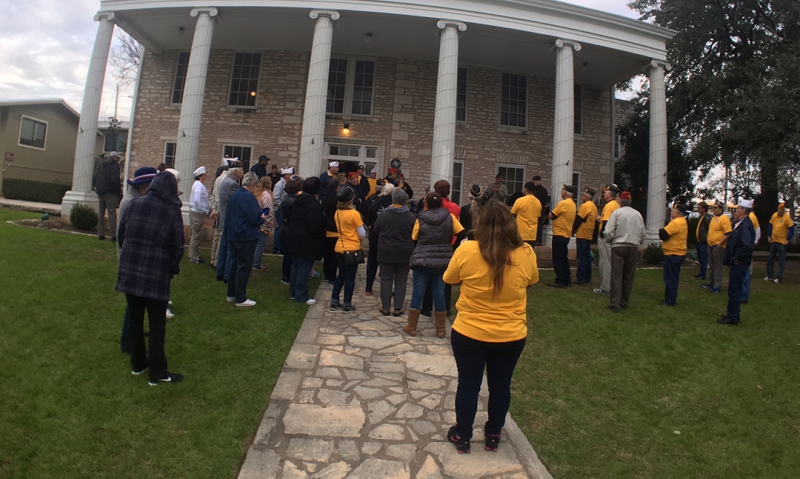
National Commander Charles E. Schmidt led a Walk for Veterans in Austin.
The local Fox news anchor announced that the “U.S’s most active veterans volunteer group took to the streets of Austin (Texas)” last Friday to bring attention to the issues veterans and their families face. But The American Legion Walk for Veterans, led by National Commander Charles E. Schmidt, was more than just an attention-getter to the dozens of participants in the Lone Star State. It served as an opportunity to raise money for the Legion's Temporary Financial Assistance program and training for American Legion service officers.
Taking a scenic route along the banks of the Colorado River and the shore of Lady Bird Lake, Department of Texas Legion family members departed from Col. William B. Travis Post 76 – home of the past two Texas department commanders and site of a historic 1858 ranch house that the Legion purchased for $5,000 in 1925.
“This post formed the first Auxiliary in the state of Texas,” said Department Commander Walter E. Ivie. “The Auxiliary sold chicken dinners to pay the mortgage. Sometimes I remind our members who it was that paid for our post.”
Although she did not come bearing a mortgage payment, American Legion Auxiliary National President Mary Davis came from her home state of Washington to join the walk.
“As long as we have an opportunity to talk to people and get press coverage, these walks are an important way to let people know who we are and what we do,” Davis said. “What’s important is that our veterans gave up what I consider a normal life at home with their families and traveled the world to actually make sure our country is safe and secure.”
Although the walk was less than two miles, Schmidt noted that it still represented a challenge for some of the participants.
“Although some of us may be a little stiff in the morning, it is nothing like the physical sacrifice and suffering that some of our veterans have gone through and what our active-duty military members do on our behalf every day,” he said. “We saw people on this walk helping each other, which is really what The American Legion is all about.”
Service and sacrifice is a tradition for Post 76, named after the commander of the Alamo who signed his final letter from the garrison, “VICTORY OR DEATH.”
“The post is starting to grow again. Those who are joining us want to get actively involved,” said Post 76 Commander Wayne A. Courreges Jr. “We have a new post newsletter editor and new web master. We have another new member who works for the VA and wants to be a service officer. We have a new program where we go from door to door asking local veterans to join us. We also have an annual dinner where our Boys and Girls State graduates share their experiences. We sponsor JROTC and have our own honor guard. We sponsor Boy Scouts. We don’t have a bar here. We don’t need one, and we don’t want one.”
The picturesque pre-Civil War stone home, built by Swedish immigrant Charles Johnson, is a popular venue for wedding rentals and other occasions.
The grounds, which include two World War I howitzers, several oak trees and six massive stone columns in front of the home, was considered “far out of the city,” when Johnson settled there.
“So wild was the country at that time that it was considered risky to live so far out of town on account of the Indians in the hills across the river,” researcher Annie Taylor wrote in a 1941 history of the post. “Though these Indians were frequently seen across the river and sometimes came across at the ford just below the house, none of them ever made the least trouble, it is said.”
One Legionnaire who was not afraid to make a little trouble, albeit for a great cause, is Ken Tooke. Tooke, an Air Force veteran of the Gulf War, had his application to use the state’s popular Hazlewood Act college tuition assistance program denied. The rationale behind the denial was Tooke’s service in the reserves at the time of his application.
“The American Legion helped me tell my story to the Texas legislature,” Tooke said. “I testified before a committee and they changed the policy. I won and was able to get a degree in anthropology and archaeology, all because of The American Legion.”
Just another of the many reasons why The American Legion continues to “walk for those who marched for us.”
- Commander

